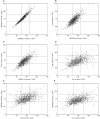Predictivity of survival according to different equations for estimating renal function in community-dwelling elderly subjects
- PMID: 18988669
- PMCID: PMC2721425
- DOI: 10.1093/ndt/gfn594
Predictivity of survival according to different equations for estimating renal function in community-dwelling elderly subjects
Abstract
Background: Detection of subjects with early chronic kidney disease (CKD) is important because some will progress up to stage 5 CKD, and most are at high risk of cardiovascular morbidity and mortality. While validity and precision of estimated glomerular filtration rate (eGFR) equations in tracking true GFR have been repeatedly investigated, their prognostic performance for mortality has not been hitherto compared. This is especially relevant in an elderly population in whom the risk of death is far more common than progression.
Methods: We analysed data of participants in the InCHIANTI study, a community-based cohort study of older adults. Twenty-four-hour creatinine clearance (Ccr), Cockcroft-Gault (C-G) and Modification of Diet in Renal Disease (MDRD)-derived equations (six and four input variables) were calculated at enrolment (1998-2000), and all-cause mortality and cardiovascular mortality were prospectively ascertained by Cox regression over a 6-year follow-up.
Results: Of the 1270 participants, 942 (mean age 75 years) had complete data for this study. The mean renal function ranged from 77 ml/min/1.73 m(2) by Ccr to 64 ml/min/1.73 m(2) by C-G. Comparisons among equations using K/DOQI staging highlight relevant mismatches, with a prevalence of CKD ranging from 22% (MDRD-4) to 40% (C-G). Reduced renal function was a strong independent predictor of death. In a Cox model--adjusted for demographics, physical activity, comorbidities, proteinuria and inflammatory parameters-participants with Ccr 60-90 ml/min/1.73 m(2) and Ccr <60 ml/min/1.73 m(2) were, respectively, 1.70 (95% CI: 1.02-2.83) and 1.91 (95% CI: 1.11-3.29) times more likely to die over the follow-up compared to those with Ccr >90 ml/min/1.73 m(2). For the C-G, the group with values <60 ml/min/1.73 m(2) had a significant higher all-cause mortality compared to those with values >90 ml/min/1.73 m(2) (HR 2.59, 95% CI: 1.13-5.91). The classification based on the MDRD formulae did not provide any significant prognostic information. The adjusted risk of all-cause mortality followed a similar pattern when Ccr and estimating equations were introduced as continuous variables or dichotomized as higher or lower than 60 ml/min. C-G was the best prognostic indicator of cardiovascular mortality. Possibly, Ccr and C-G are better prognostic indicators than MDRD-derived equations because they incorporate a stronger effect of age.
Conclusions: In a South-European elderly population, the prevalence of CKD is high and varies widely according to the method adopted to estimate GFR. Researchers and clinicians who want to capture the prognostic information on mortality related to kidney function should use the Ccr or C-G formula and not MDRD equations. These results highlight the importance of strategies for early detection and clinical management of CKD in elderly subjects.
Figures




Similar articles
-
Assessment of GFR by four methods in adults in Ashanti, Ghana: the need for an eGFR equation for lean African populations.Nephrol Dial Transplant. 2010 Jul;25(7):2178-87. doi: 10.1093/ndt/gfp765. Epub 2010 Jan 25. Nephrol Dial Transplant. 2010. PMID: 20100724 Free PMC article.
-
Comparison of the prevalence and mortality risk of CKD in Australia using the CKD Epidemiology Collaboration (CKD-EPI) and Modification of Diet in Renal Disease (MDRD) Study GFR estimating equations: the AusDiab (Australian Diabetes, Obesity and Lifestyle) Study.Am J Kidney Dis. 2010 Apr;55(4):660-70. doi: 10.1053/j.ajkd.2009.12.011. Am J Kidney Dis. 2010. PMID: 20138414
-
[Evaluation of the applicability of three prediction equations for estimating glomerular filtration rate in children with chronic kidney disease].Zhonghua Er Ke Za Zhi. 2010 Nov;48(11):855-9. Zhonghua Er Ke Za Zhi. 2010. PMID: 21215031 Chinese.
-
Performance of the Cockcroft-Gault and MDRD equations in adult Nigerians with chronic kidney disease.Int Urol Nephrol. 2009;41(3):635-42. doi: 10.1007/s11255-008-9515-8. Epub 2009 Jan 10. Int Urol Nephrol. 2009. PMID: 19137410
-
A Comparison of GFR estimating formulae based upon s-cystatin C and s-creatinine and a combination of the two.Nephrol Dial Transplant. 2008 Jan;23(1):154-60. doi: 10.1093/ndt/gfm661. Epub 2007 Oct 2. Nephrol Dial Transplant. 2008. PMID: 17911090 Review.
Cited by
-
A Study of the Applicability of GFR Evaluation Equations for an Elderly Chinese Population.J Nutr Health Aging. 2015 Jun;19(6):693-701. doi: 10.1007/s12603-015-0494-z. J Nutr Health Aging. 2015. PMID: 26054507
-
Combining multiple continuous tests for the diagnosis of kidney impairment in the absence of a gold standard.Stat Med. 2011 Jun 30;30(14):1712-21. doi: 10.1002/sim.4203. Epub 2011 Mar 22. Stat Med. 2011. PMID: 21432889 Free PMC article.
-
Performance of Cockcroft-Gault, MDRD, and CKD-EPI in estimating prevalence of renal function and predicting survival in the oldest old.BMC Geriatr. 2013 Oct 25;13:113. doi: 10.1186/1471-2318-13-113. BMC Geriatr. 2013. PMID: 24160772 Free PMC article.
-
Structured clinical follow-up for CKD stage 5 may safely postpone dialysis.J Nephrol. 2015 Aug;28(4):463-9. doi: 10.1007/s40620-014-0123-7. Epub 2014 Jul 18. J Nephrol. 2015. PMID: 25035094
-
Omega-3 and renal function in older adults.Curr Pharm Des. 2009;15(36):4149-56. doi: 10.2174/138161209789909719. Curr Pharm Des. 2009. PMID: 20041816 Free PMC article.
References
-
- National Kidney Foundation K/DOQI clinical practice guidelines for chronic kidney disease: evaluation, classification, and stratification. Am J Kidney Dis. 2002;39:S1–S266. - PubMed
-
- Levey AS, Coresh J, Balk E, et al. National Kidney Foundation practice guidelines for chronic kidney disease: evaluation, classification and stratification. Ann Intern Med. 2003;139:137–147. - PubMed
-
- Levey AS, Eckardt KU, Tsukamoto Y, et al. Definition and classification of chronic kidney disease: a position statement from Kidney Disease Improving Global Outcomes (KDIGO) Kidney Int. 2005;67:2089–2100. - PubMed
-
- Coresh J, Byrd-Holt D, Astor BC, et al. Chronic kidney disease awareness, prevalence and trends among US adults, 1999 to 2000. J Am Soc Nephrol. 2005;16:180–188. - PubMed
-
- El Nahas AM, Bello AK. Chronic kidney disease: the global challenge. Lancet. 2005;365:331–340. - PubMed
Publication types
MeSH terms
Grants and funding
LinkOut - more resources
Full Text Sources
Medical
Research Materials
Miscellaneous

